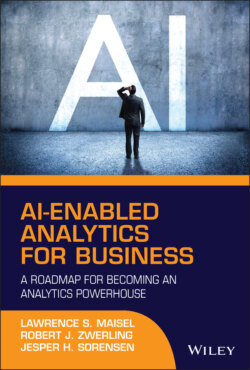Читать книгу AI-Enabled Analytics for Business - Lawrence S. Maisel - Страница 28
BASS-ACKWARD
ОглавлениеA director for a technology venture accelerator asked two of his portfolio companies that had AI products to help him with a problem he thought AI could solve in his venture portfolio management. The director was in the middle of describing his problem when the founder of one company said the solution was using ML with JSON. The founder of the other AI company said, “Hold on! We don't even know the problem yet, to know what technology to bring to bear.”
This is a common error for people in technology: putting technology in front of the problem. It is like bringing plumbing tools before knowing if the problem is plumbing or carpentry. This is simply a backward approach to problem solution, affectionately known as bass-ackward.
By focusing on technology first, the business problem or optimization being sought becomes secondary. The quest becomes finding people with skills who know the technology selected and tools that run the technology. Once found, they are given the “secondary” task to solve the problem; but their interest lies in using the technology, not in solving the problem. These people want to be clever about what the technology can do vs. curious about what insights can be gained from the data. This gap often manifests itself in more limited results for the business.
In combination with leaping to a particular technology is making the solution overly complex. For example, I sat with a PhD statistician at a large telecom company discussing demand forecasting. I had selected a particular forecast formula using a single variable to forecast demand from historical shipment data. Back-testing confirmed greater accuracy than was being achieved by the company's current method. The statistician wanted a similar forecast formula but with multiple variables and using as data inputs two other forecasts: the internal forecast and customer forecast.
His theory was that the internal forecast skewed lower than actual demand and the customer forecast skewed higher; thus, the blend should yield a more accurate forecast. I opined that this approach of using two forecasts to make a third forecast was like two drunks trying to help each other home. He disagreed, and I wished him well in his efforts to prove his methodology.
As predicted, the statistician's efforts were unfruitful, and when we resumed our talks, he now wanted to manipulate my formula by adding more variables. I reminded him that the forecasts achieved with my method had materially better accuracy and we were now pressed for time to deploy a forecast. The adage we should heed is, a good plan today is better than a perfect plan tomorrow.
Nevertheless, the statistician said he would not accept any forecast that was not multi-variable and that he could not manipulate, regardless of the accuracy of the results. He was focused on mathematics for the sake of mathematics and not the accuracy of the forecast for business. At this point, I wished him well and departed his company for the last time.
Einstein said, “Everything should be made as simple as possible, but not simpler.”4 Wise words that all statisticians and data scientists should heed, as leading with their ego to show everyone how smart they are only introduces complexity that ultimately breeds error. The solution to bass-ackward remains for the business and its users to define the problem and drive the analytics solution.
